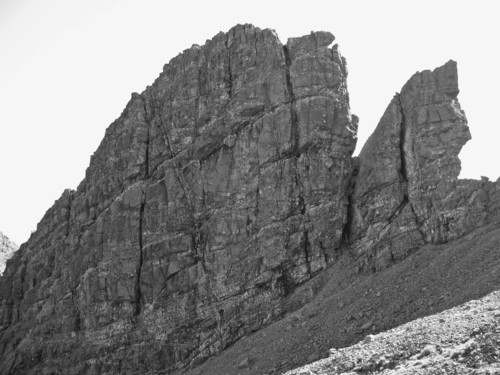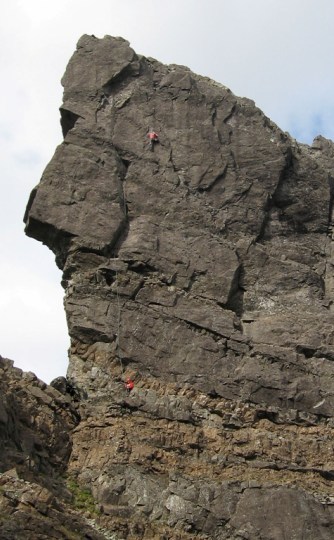Incredible History
Writing the SMC guidebook has been a fascinating process aided mainly by the text produced by the research of Stuart Pedlar. Those who think history is boring should read on…
After Wednesday’s ascent of the outside variation to Shadbolt’s Chimney I struggled to find the description of the original summer ascent. I informed Martin, Pete & Francis that it had been done in 1932 and e-mailed Stuart for clues. Meantime Martin gave me the description-
Shadbolt’s Chimney: Shoot the Bolt VII, 7 ** A winter ascent of the outside of the chimney (avoiding the tunnelling through-route). A short awkward step led into the cavern. The 8 metre roof of the chimney gave a unique and brilliant pitch with sustained back and foot techniques leading to a heavily rimed exit squeeze.
F.Blunt, P.MacPherson, M.Moran 2nd Dec 2010
with the comments-
I’m amazed that the outside of the chimney was only VDiff – they were very brave in those days! They would have had no gear and the chimneying felt like VS, 4c to me. Maybe downgrade the winter ascent to VI, 7 and forget the name.
We had no idea about earlier ascents, so we were somewhat intimidated. Pete struggled quite a lot on the lead, and Francis looked suitably stressed seconding! Given that we cruised The Secret a week earlier I get more rather than less confused about gradings as the years go by.
SHADBOLT’S CHIMNEY IS THE OBVIOUS FAULT IN THE TOOTH

To cap it all Stuart has come back with the amazing full story from his book (that will be published sometime after the SMC book is printed)-
’Tarbuck later explained how he and Geoffrey Collin ‘climbed the Tooth by Naismith’s route. I moved to the opposite edge and looked down the north face, and was surprised to find that the upper half was sufficiently broken up to allow some good climbing.
There was not the slightest chance of making a complete descent, however, as the lower part of this face is composed of rotten rock which has weathered away, leaving the top overhanging the base. I climbed down as far as the overhang, where every possibility ceased. The position was thrilling, for the lower rocks cannot be seen, and nothing meets the eye till the upper scree of Coire a’ Bhasteir; even the assurance of a rope from above could not entirely alleviate the sensation.
Descent being out of the question, I traversed away to the left, and after a difficult corner found myself looking down into the outside cleft of the North Chimney, and as overhangs have no terrors in a chimney, it occurred to me that here might be a way down. I was now too far to the left to get full protection from my rope, so I traversed back and ascended the face. We moved over to a better position directly above the chimney. The chimney is not obvious from above, and it dies out on the face just short of the top, but the position can be got by moving towards the edge from the exit-hole of Shadbolt’s climb and keeping along the strata.

CAPTAIN PLANET E4, 6a on the opposite face of the Basteir Tooth.
I took my turn at holding the rope, whilst Collin disappeared over the edge; the rope paid out steadily for the whole 100 feet, and I knew he must have succeeded in reaching the foot. Shouting as hard as we could, we were unable to hear one another, our voices being thrown out across the corrie by the intervening rocks, so I belayed his rope and moved back to the exit-hole of Shadbolt’s climb, through which we were able to converse without raising our voices. Collin had reached the floor of the upper cave above the first difficult pitch of Shadbolt’s climb. He untied; I took in his rope, and brought it down with me via the subterranean route, and joined him in the bed of the chimney. The cave is roofed in some 40 feet up, and whereas Shadbolt’s route goes through a hole at the back of the roof into complete darkness, our route rounded the outer extremity of the roof and carried on into the daylight. Collin was optimistic about the ascent, and very kindly offered me the lead. The only trouble he thought might be the rounding of the roof where he walls were rather far apart. I backed up to the roof and then outwards horizontally under it until I could round the end. The leader here is actually well outside the second man, adding sensation to the position, without being too difficult. Just as the walls are getting unpleasantly far apart, relief as afforded by a large slab of rock which blocks the chimney and forms a crack with the left (east) wall. The climber transfers himself into the crack, which just admits the body; this move can be protected by threading the rope through a small, well-placed chockstone. Once in the crack the climbing is constrictive, and 20 feet of wriggling is required to reach the jumbled blocks that are jammed in the head of the chimney. Once out of the chimney, easy climbing leads to two huge blocks, where the second may be brought up. This finishes the climb. One hundred feet of rope is required’
Tarbuck says the grading of this route would vary with the length of the climber’s leg: ‘long legs being at a premium.’ He also doubted whether theirs was in fact the first ascent: ‘it is a wonder that Shadbolt did not take it in the first place, it is much easier to find than his amazing through route. The fact that it overhangs and shows little promise from below may account for its neglect. We, of course, spotted it from above.’
Ken Tarbuck, from Upton, Wirrall, Cheshire, was noted for his great number of experiments from which he had evolved a remarkable method of holding a falling leader by means of a waist belay and controlled sliding friction He also invented a friction karabiner, by which means a rope, as it tightened, could be compressed in a V groove, and so brought under perfect control.
Shadbolt first climbed the original with MacLaren five years before the pair made the best known ‘first’ in the whole range; a complete traverse of the Main Ridge (1911).






